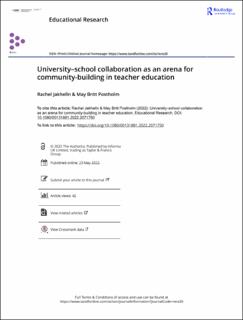| dc.description.abstract | Background
In many settings internationally, initial teacher education (ITE) relies on cooperation between schools and universities. When these institutions collaborate on teacher education, the shared work can form a basis for community building. This article focuses on experiences in Norwegian ITE of the Change Laboratory (CL), a form of participatory data analysis workshop, as an arena for such work, and hence community building, in teacher education.
Purpose
Contextualised within the framework of cultural historical activity theory (CHAT), the research aimed to understand participants’ experiences of collaboration in CLs, and how the CLs functioned as an arena for community building. We asked: in what way was the work in CLs during the first year of an intervention research project in teacher education experienced as community building?
Method
The research was conducted within a four-year teacher education research and development project involving two ITE institutions. We carried out focus group interviews with three groups engaged together in shared work: teacher educators in university (n = 10), teacher educators in school (n = 5), and student teachers (n = 20). Data were analysed qualitatively.
Findings
During the project, all participants gradually felt that they had a voice and were listened to. Their mutual engagement on the project work, and the use of CHAT also brought them together. Overall, the findings were encouraging and suggested that a focus on community building in CLs in the start-up phase of a project can lay the foundation for collaboration between teacher education and schools, contributing to the co-construction of knowledge, and to learning and development. However, the challenge of disseminating the work to colleagues in universities and schools was perceived as a hindrance.
Conclusions
The development and sustaining of collaboration in teacher education is an important goal, ultimately benefitting the entire learning community. Crossing boundaries can lead to joint learning, as in this project, and to further development and learning in teacher education. | en_US |

